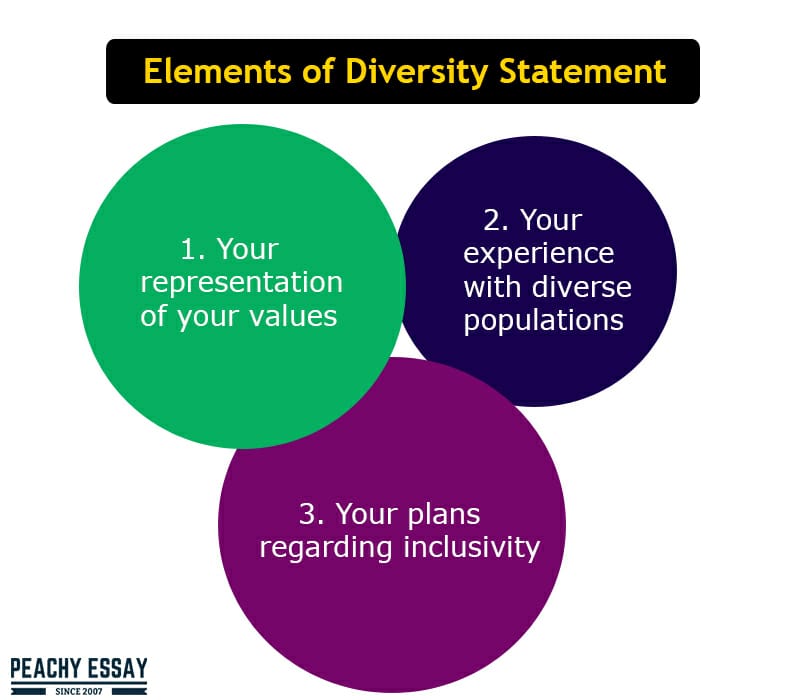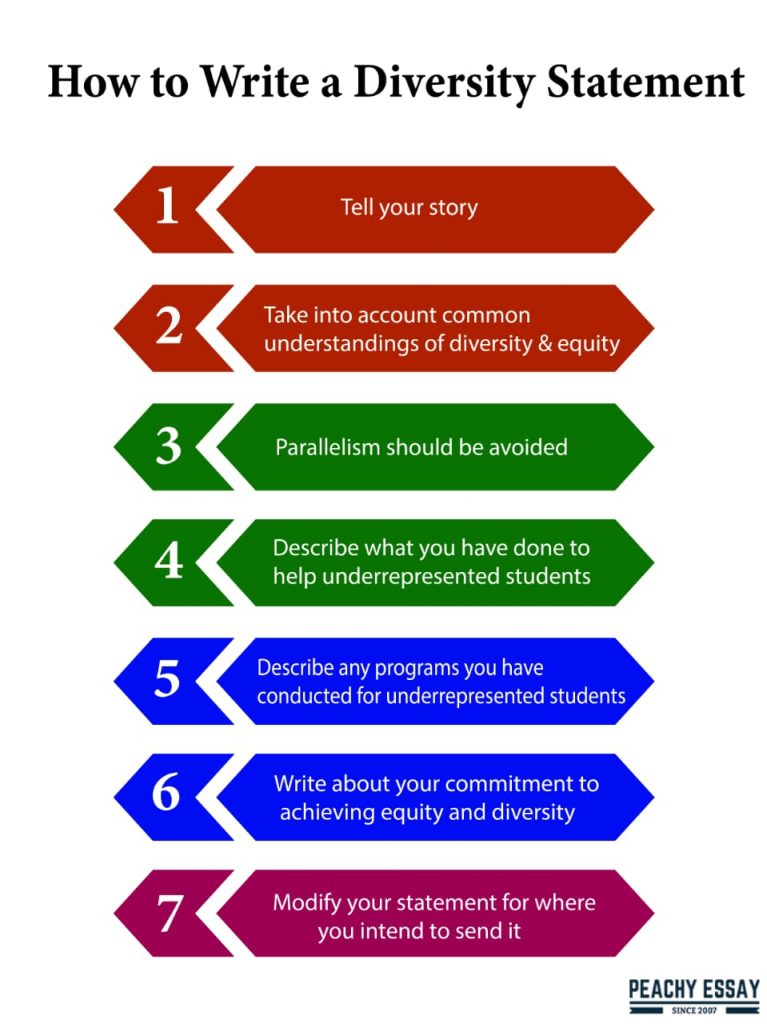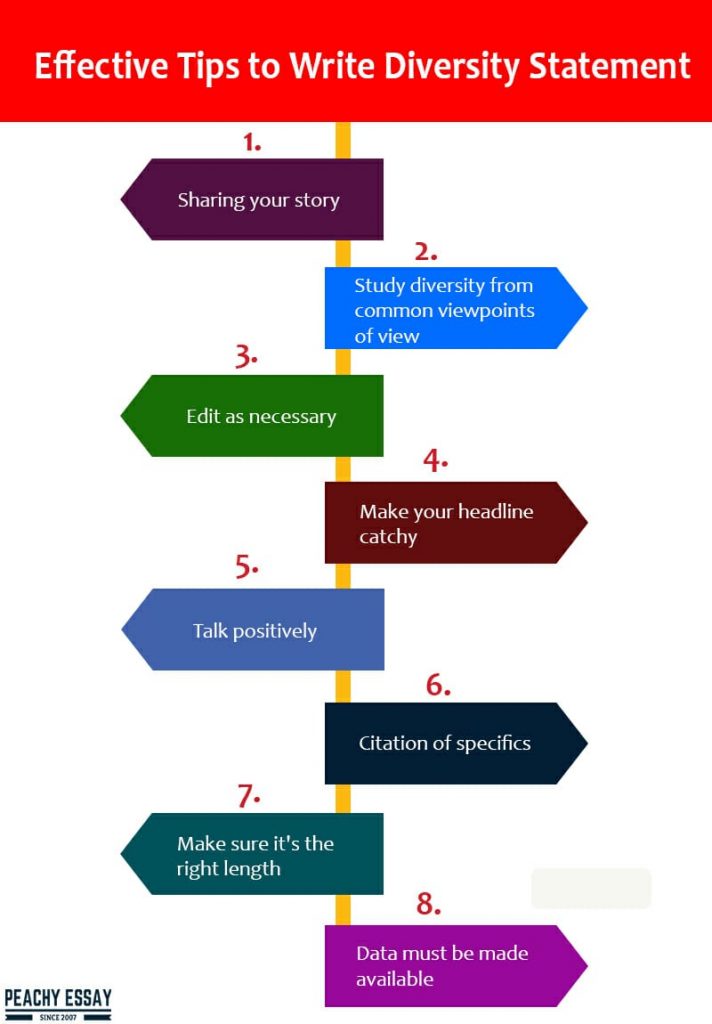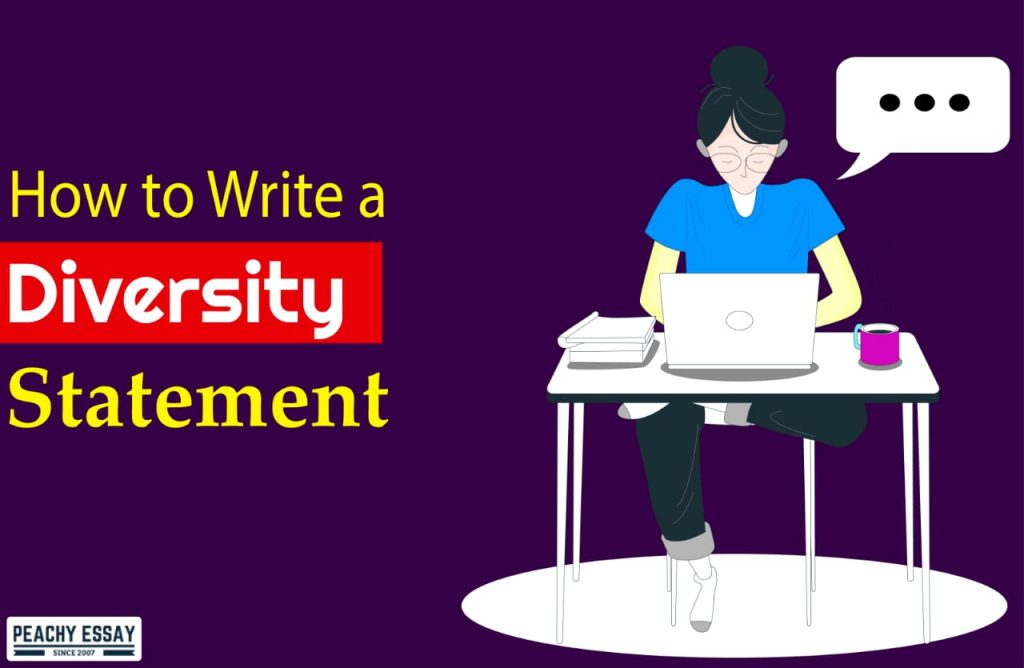Diversity statements have become increasingly common in faculty job postings, along with statements about research and teaching. While applying to university faculty positions, you may be asked to provide a diversity statement. Most faculty and graduate students have never written this part of a faculty job application unless they were required to do so.
What is a Diversity Statement?
Diversity statements explain your experiences and commitments to diversity on a single page. Any university that requests a diversity officer is very committed to inclusivity and supporting their diverse population, so they are looking for someone who supports that mission. As with a teaching statement, your inclusions will vary according to what you believe or have done.
A diversity statement might include the following three elements:

The Purpose of a Diversity Statement
Candidates are considered for the position based on their professional skills, experience, and/or willingness to participate in activities that would enhance campus diversity and equity efforts. The purpose of these statements is to allow applicants to describe their unique experiences and commitment to a search committee.
What are the Best Ways to Write an Effective Diversity Statement?
As a job candidate, how do you inform a search committee that you are committed to diversity and equity? You should not write a throwaway diversity statement. Many candidates do not want to write diversity statements showing their interest in diversity and equity for fear that they will be viewed as too political. In such a way, they write something blasé, such as offering students the possibility to attend class in pajamas if they want to. It is an ineffective strategy, as it fails to demonstrate a genuine commitment to equity and diversity.
There is no doubt that many academic faculty members overtly reject campus efforts to benefit diversity and equity. On the other hand, search committee members do not think about diversity or read diversity statements. Search committee members who aren’t concerned with teaching ignore the division of duties statement, just as those who aren’t concerned with diversity overlook the division of duties statement. Therefore, don’t write an affirmative action statement directed at faculty members who are indifferent to diversity. Ensure that you write one for those faculty members who will take the time to read your statement carefully.
Here is how to write a diversity statement.

Tell your story
Highlight the obstacles you have overcome to reach your current position. Alternatively, if you consider yourself to be privileged, you should acknowledge that as well. You certainly deserve the attention of others if you grew up carrying two sacks of rice that weighed 20 pounds on your back uphill to school. You should acknowledge your privilege if you were raised with a silver spoon in your mouth. It doesn’t matter how you tell the story; you’ll be able to demonstrate empathy for students facing challenges on their way to meeting their educational goals.
Take into account common understandings of diversity and equity
Pay attention to issues such as race, sexual orientation, gender, socioeconomic status, and class. Write about how difficult it is to be a Kansan in Missouri instead of trying to tone your statement down. Rather, discuss racial oppression, sexism, homophobia, transphobia, ableism, or some other form of widely recognized oppression.
Parallelism should be avoided
Don’t compare the discrimination you experienced because you’re a Kansan in Missouri with black students’ discrimination at mainly white schools. To have insight into the challenges African Americans face, you do not need to be an African-American, but if you have no first-hand experience with racism, don’t claim it. Rather than writing about what you don’t know, write about what you do know. You may write about your own experiences of privilege or oppression if you feel comfortable doing so. You don’t have to get personal with your arguments; cite statistics and studies.
Describe what you have done to help underrepresented students
Don’t hesitate to help others if you haven’t done so before. Consider tutoring or volunteering at an underperforming school, building a house with Habitat for Humanity, or teaching antiracist pedagogy. As well as writing about a rewarding experience in your diversity statement, you can include it.
Describe any programs you have conducted for underrepresented students
If you have been involved with any such programs (e.g., McNair Scholars Program), then please describe that experience in your statement. It can include being a former participant, mentor, or adviser to someone who has participated. By using such specific examples, you demonstrate an understanding of how successful programs are designed.
Write about your commitment to achieving equity and diversity
It would be best if you described how you could contribute in specific ways. If you are interested in creating new programs based on the models used by other campuses, you can mention your willingness to contribute to pre-existing programs on the campus.
Modify your statement for where you intend to send it
The same statement you write for an institution in the rural South should not be sent to an elite institution in California. In your statement, you should mention the demographics of the institution to which you are applying. If, for example, you are applying to Hispanic-serving universities, you should be aware that this is a factor. In addition, if it offers a scholarship program for underrepresented minorities, you should mention it.
How do you write a Business Diversity Statement?
You can create a diversity statement for your organization to explain how it approaches diversity, equity, and inclusion throughout its staff and customer base. You can use it to show stakeholders how diversity contributes to the values and mission of your organization.
Keeping diversity, equity, and inclusion in mind may seem like just another fad. However, it’s not a factor to ignore for businesses committed to pursuing the best talent.
DEI (Diversity Equity, and Inclusion) commitments are a critical element of your employer brand, which begins at the start of your talent sourcing process. Building your employer brand by creating a diversity statement will show that you take diversity seriously and have paid attention to it.
It would be best to consider the feelings of numerous stakeholders (internal and external) when developing a diversity statement. Diverse statements that are poor (or none at all) can undermine the mission and values of your organization.
How to write a Business Diversity Statement
Consider your mission, values, and vision when writing a diversity statement for yourself or your organization. In addition, keep in mind how different stakeholders will interpret your statement. To prevent people from believing you foster an unwelcoming work environment, diversity statements should be developed in conjunction with recruitment marketing objectives.
When a diversity or position statement is released, people are likely to examine it, create a waterproof document, and leave no room for misinterpretation. If your organization needs assistance in creating content, you may benefit from hiring a copywriter or agency.
The Diversity College Essay
To have a diverse student body, colleges require diverse essays explaining different ethnicities, cultures, religions, backgrounds, interests, etc. In the essay, students are asked to explain what makes them unique so that admissions committees know what kind of diverse views and opinions they can bring to campus.
Here, we’ll discuss what Diversity Essays are, what real examples of Diversity Essays are, and tips on how to write a standout Diversity Essay. After reading this post, you’ll be ready to answer this common essay prompt.
What is a Diversity Essay?
You must submit two types of essays in college admissions: the personal statement and supplemental essays. Personal statements are the main application essays you send to all the schools you apply to via the Common App. An essay of this length usually has about 500-650 words, and it emphasizes who you are and what you care about.
Additional essays are prompts that are specific to a school, so they only go to those schools. The average student has to write between 100-400 words in each of 1-3 essays. A lot of schools use these essays to determine your academic or extracurricular fit with the school. Typical prompts include “Why this College?” What is your favorite extracurricular activity?” and “Why You Want This Major?”
As part of the personal statement and the supplemental essay, diversity essay prompts are scattered throughout. In all college essays, the purpose is to understand better who you are and what you care about. You can express yourself through your essays and make your application humane. In particular, the diversity essay seeks to understand how you might uniquely contribute to the college community.
In addition to undergraduate admissions, diversity essays are often used for graduate admissions and scholarship competitions. You might very well be tasked with writing another diversity essay in the future, so it’s definitely a good idea to familiarize yourself with this essay archetype now.
Diversity Essay Prompt Examples
Common App prompts for diversity essays are the most famous.
Here are the prompt examples:
- In some cases, students have a special background, identity, interest, or talent that they believe their application would be incomplete without it. Tell us about yourself if this rings true for you.
- Our campus community is praised for creating a collaborative atmosphere that enhances the quality of life for all. Every student brings a unique set of life experiences and cultural traditions to the Residential College System. How would you contribute to the life at Rice from a personal perspective? (500 words)
A college will always want you to demonstrate what you will benefit the community by doing.
Why Does Diversity Matter at School?
According to admission officers, diversity in the classroom helps all students succeed in their academic careers.
When there are different perspectives available in classrooms, dorms, dining halls, and study groups, the discussions will be richer, and the teams will be more creative.
Furthermore, by learning and growing in this multicultural environment, students are prepared to work when cultures are becoming increasingly multicultural and global; having a heterogeneous workforce benefits those who were previously underrepresented in medicine, for example.
The medical industry, for example, benefits from a diverse workforce that includes people from previously underrepresented cultures. A company will be more effective at marketing if it can reach a variety of markets and audiences. Schools want graduates to be prepared for the job market in the 21st century.
Different Ways to Display your Diversity
The Adcom is interested in your diversity and how it has shaped your character and personality traits, as well as the unusual experiences you’ve had along the way.
Here are seven examples you could write about
- As a child, you were taught to respect elders, attend family events, and learn your parents’ native language and culture.
- A strong sense of teamwork has always been instilled in you by your grandparents and extended family.
- It has been difficult for you because your parents’ values conflict with your peers’ values.
- Teachers often do not understand how your cultural background or social environment affects your performance outside of school.
- Discrimination was a part of your life, but you could succeed despite it because of the grit, values, and character you displayed.
- When you lived an unusual lifestyle – e.g., living overseas as the child of diplomats or contractors, performing professionally in the theater, dancing, music or sports arenas, or having a hearing sibling – you learned unique skills.
- A time when you experienced racism (either toward you or others) and responded by actively promoting diverse, tolerant values.
The Best Way to Write about your Diversity
As you answer the diversity question, you should explain how your experiences have shaped how you perceive things, develop relationships, and build empathy.
Make sure you answer the specific question posed by the school, whether it is about how you see diversity or how you can assist in the development of diversity at the school, in your profession, or in your community. You should highlight a distinctive characteristic about yourself that will add to the mosaic of the class mosaic every atom is attempting to build. Adcoms desire that every student contribute to the whole picture. Your goal is to stand out but also complement the school’s overall look.
To help you think more broadly about diversity, here’s a simple three-part framework:
Identity
What kind of person are you? In what ways has your identity been shaped by your experiences? Is there anything that you do that makes you stand out from the crowd? A person’s identity can include any number of factors, including but not limited to the following: gender, sexual orientation, ethnicity, disability, religion, non-traditional work experience, non-traditional educational background, multicultural background, and the educational level of the family.
Deeds
How has your work gone? Do you have any accomplishments you would like to share? It may include the following:
- Achievements both inside and outside your field of study
- Opportunities for leadership
- Service to the community
- Experience in the military
- Experience as an intern or professional f. Research possibilities
- Interests
- Travel
Ideas
What are your thoughts? What is your approach to things? What motivates you? Who or what influences you?
If you want to write about your contribution to the community at your target school successfully, you only need to examine your identity, your acts, and your ideas from the perspective of your own individuality.
Tips on Writing a Diversity Statement

Sharing your story
Diverse experiences will be unique to each individual. You mustn’t be afraid of sharing the things which make you unique. We do not expect you to share all the details of your personal history with us if that is not something you feel comfortable doing at the moment. However, it can sometimes be helpful to describe your experiences, especially if they provide you with a particular understanding of how to work with a particular population or group. It is probably wise to avoid any description of mental health problems that could suggest that you might not be able to adequately handle the job demands, for example, if you have bad depression.
Study diversity from common viewpoints of view
It can be based on race, class, gender, or sexual orientation. If they ask about diversity, they’re probably talking about this, and if you talk about other types of diversity, they may take it as unreliable. Even though you might have had to adjust to a different environment after moving from Georgia to New York, many readers of your statement will not see the relevance in that unless it was connected to your experiences or being a member of an ethnic minority in that new environment.
Edit as necessary
Diversity may carry different meanings at a school with a high Hispanic and African American population than at a school with fewer Hispanics and African Americans, but with a high proportion of first-generation students or students with differing religious beliefs. If you are planning to implement future programs at those schools, it is important to think about their population.
Make your headline catchy
Your diversity statement can be encapsulated in a headline. Simple phrases that are easy to remember will benefit your whole company and even external stakeholders. In your diversity statement, these headlines will introduce your diversity statement and motivate people to read further.
Talk positively
I was hoping you could stick with me on this trip, even though it seems obvious. There is a certain amount of subjectivity in positive language. If you choose words that evoke positive emotions instead of negative ones (e.g., inclusive, celebrate, grow, freedom, commitment, experience), you will increase your chances of success.
Citation of specifics
Diversity statements are made stronger by identifying concrete ways your company is committed to DEI initiatives, not just by stating overarching themes and ideas. Taking the time to recognize specific resources or internal support groups shows that you go beyond words.
Make sure it’s the right length
Keep in mind that you’re writing a statement, not a thesis. As a general rule, don’t exceed 100 words. Supporting articles can always be written for the statement. Maintain your diversity statement’s conciseness and clarity throughout.
Data must be made available
The best diversity statements describe how an organization is progressing in creating an inclusive and diverse work environment. Ideally, your company’s employees should have freely available demographic data on their ages, ethnicities, and genders (both self-reported and anonymous). By sharing this with stakeholders, you show your organization’s performance in comparison with others. In the absence of this data, consider capturing employee snapshots and publishing a diversity report.




